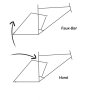Just looking at the differences between horst and faux-bar designs. I now see why such a simple thing as changing the link location makes all the difference in the world in elliminating braking and pedaling forces from altering the suspension effectiveness.
Basicly the Horst design is made to create twisting forces on the seat stay tubes, where as faux-bar only pushes on the seat stays. The twisting action of the Horst seat stay under braking wants to push into the rocker arm perpendicular to the direction of travel, thus eliminating much of any effect on the travel motion of the rocker arm. This allows it to resist braking pressures from entering the suspenion travel, very slick. It's like if you push a stick straight into the ground it will resist greatly, but on the other hand pushing straight down doesn't have much effect on how easy it is to move the stick around while pivoting it on the ground.
Did I miss anything?
Edit: As others have pointed out, the Horst design is impossible to make it so it resists braking throughout the travel path. This is due to the perpendicular force from the seat stay going into the rocker arm is only a TRUE perpendicular angle for ONE exact point in the travel. Anywhere above or below this point will result in several degrees of alteration in the angle in which the seat stay pushes into the rocker arm under braking. Thus the perpendicular point is set to at the point where the suspension sags to. Any point above or below this will cause a "slight" amount of travel resistance (before perpendicular) or travel "push" (anywhere after perpendicular point). The angle in which the seat stay pushes into the rocker arm doesn't deveate much from perpendicular, thus many people don't notice the "slight" amount of braking forces, most of it is still pushed into the seat tube without being translated into the shock motion.
Basicly the Horst design is made to create twisting forces on the seat stay tubes, where as faux-bar only pushes on the seat stays. The twisting action of the Horst seat stay under braking wants to push into the rocker arm perpendicular to the direction of travel, thus eliminating much of any effect on the travel motion of the rocker arm. This allows it to resist braking pressures from entering the suspenion travel, very slick. It's like if you push a stick straight into the ground it will resist greatly, but on the other hand pushing straight down doesn't have much effect on how easy it is to move the stick around while pivoting it on the ground.
Did I miss anything?
Edit: As others have pointed out, the Horst design is impossible to make it so it resists braking throughout the travel path. This is due to the perpendicular force from the seat stay going into the rocker arm is only a TRUE perpendicular angle for ONE exact point in the travel. Anywhere above or below this point will result in several degrees of alteration in the angle in which the seat stay pushes into the rocker arm under braking. Thus the perpendicular point is set to at the point where the suspension sags to. Any point above or below this will cause a "slight" amount of travel resistance (before perpendicular) or travel "push" (anywhere after perpendicular point). The angle in which the seat stay pushes into the rocker arm doesn't deveate much from perpendicular, thus many people don't notice the "slight" amount of braking forces, most of it is still pushed into the seat tube without being translated into the shock motion.
Attachments
-
32.6 KB Views: 223
